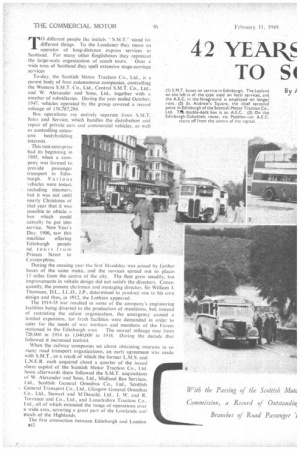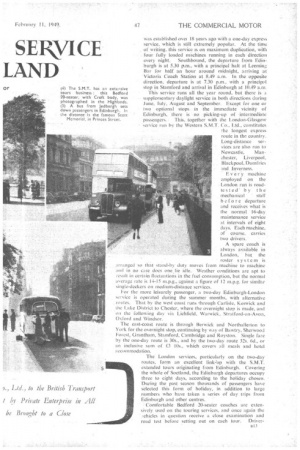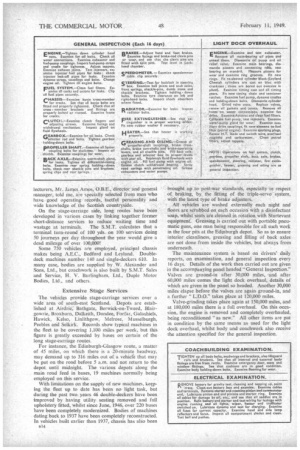42 YEAR),_
Page 20

Page 21

Page 22

Page 23

If you've noticed an error in this article please click here to report it so we can fix it.
TO S4
SEWICE LAND
T, 0 different people the initials " SALT." stand foi different things. To the Londoner they mean an operator of long-distance express services to Scotland. For many other Englishmen they represent
the large-scale organization of coach tours. Over a wide area of Scotland they spell extensive stage-carriage .. services ' To-day, the Scottish Motor Traction Co., Ltd., is a parent. body of four autonomous companies, Controlling the Western S.M.T. Co., Ltd., Central S.M.T. Co., Ltd., and W. Alexander and Sons. Ltd., together with a number of subsidiaries. During the year ended October. 3947, vehicles operated by the group covered a record mileage of 138,787,294.
. Bus operations are entirely separate from S.M.T.. Sales and Service, which handles the -distribution arid repair of private cars and commercial vehicles, as well as controlling exten sive bodybuilding interests. '
. This vast enterprise had its beginning in 1905, when a company was formed to. provide passenger transport in Edinburgh. Various vehicles were tested, including steamers, but it was not until • nearly Christmas of that year that it was possible to obtain a bus which could actually he put into service. New Year's Day, 1906, saw, this machine offering Edinburgh people 6d, tours from Princes Street to Corstorphine. .
Miring the ensuing year the first Maudslay was joined by further buses of the same make, and the services spread out to places 13 miles from the centre of the city. The fleet grew steadily, but improvements in vehicle design did not satisfy the directors. Consequently, the present chairman and managing director. Sir William J. Thomson, D.L., LL.D., J.P., determined to produce one to his own design and thus, in 1012, the Lothian appeared.
The 1914-18 war resulted in some of the company's engineering facilities being diverted to the production of munitions, but, instead of restricting the infant organization, the emergency caused a limited expansion, tor fresh facilities were demanded in order to cater for the needs of war workers and members of the Forces stationed in the Edinburgh area The annual mileage rose from 728,000 in 1914 to 1,040,000 in 1918. During the decade that followed it increased tenfold.
When the railway companies set about obtaining interests in so many road transport organizations, an early agreement was made with S.M.T., as a result of which the former L.M.S. and L.N.E.R. each acquired about a quarter of the issued share capital of the Scottish Motor Traction Co., Ltd. Soon afterwards there followed the S.M.T. acquisitions of W. Alexander and Sons, Ltd., Midland Bus Services, Ltd., Scottish General Omnibus Co., Ltd., Scottish General Transport Co., Ltd., Glasgow General Omnibus Co., Ltd., Stewart and M'Donald, Ltd.. J. W. and R. Torrance and Co., Ltd., and Lanarkshire Traction Co., Ltd., allot which extended the range of operations over a wide area, covering a great part of the Lowlands and • much of the Highlands.
The first connection between Edinburgh and London B12 was established ovei 18 years ago with a one-day express service, which is still extremely popular. At the time of writing, this service is on maximum duplication, with . four fully loaded machines running in each direction
every night.. Southbound, the departure from Edinburgh is at 5.30 px.m., with a principal halt at Leeming Bar for half an hour around midnight, arriving at Victoria Coach Station at 8.49 a.m. In the opposite direction, departure is at 7.30 p.m., with a principal stop in Stamford and arrival in Edinburgh at 10.49 a.m.
This service runs all the year round, but there is a supplementary daylight service in both directions during Rine, July, August and September. Except for one or two optional stops in the immediate vicinity of Edinburgh. there is no picking-up of -intermediate passengers.This, together with the London-Glasgow
-serVice run by the Western Co., Ltd., Constitutes the longest express route in the country. Long-distance services are also run to
Newcastle, Man, chester, Liverpool, Blackpool, Dumfries and Inverness. • Every machine employed on the London run is roadtested by the mechanical staff before departure and receives what is the normal 16-day maintenance service at intervals of eight days. Each machine, of course, carries two drivers.
A spare coach is always available in London, but the roster system is arranged -so that stand-by duty moves from machine to machine and in no case does one lie idle. Weather conditions are apt to result in certain fluctuations in the fuel consumption, but the normal average rate is 14-15 m.p.g., against a figure of 12 m.p.g. for similar single-deckers on medium-distance services.
For the more leisurely passenger, a two-day Edinburgh-London
service is operated during the summer months, with alternative routes. That by the west coast runs through Carlisle, Keswick and the Lake District to Chester, where the overnight stop is made,. and on the following day via Lichfield, Warwick, Stratford-on-Avon, Oxford and Windsor.
The east-coast route is through Berwick and Northallerton to
York for the overnight stop, continuing by way of Bawtry, Sherwood Forest, Grantham, Stamford, Cambridge and Royston. Single fare by the one-day route is 30s., and by the two-day route 32s. 6d., or an inclusive sum of £3 -10s., which covers all meals and hotel accommodation.
The London services, particularly on the two-day
routes, form an excellent link-lip with the S.M.T. extended tours originating from Edinburgh. Covering the whole of Soctland, the Edinburgh departures occupy three to eight days, according to the holiday chosen. -Diving the past season thousands of passengers have selected this form of holiday, in addition to large numbers who have taken a series of day trips from Edinburgh and other centres.
Comfortable Bedford 20-seater coaches are extensively used on the touring services, and once again the lehicles in question receive a close examination and road test before setting out on each tour. Driver 1113
lecturers, Mr_ James Amos, 0./3..E., director and general manager, told me, are specially.selected from men who have good operating records, tactful personality and wide knowledge of the Scottish countryside..
On the stage-carriage side, long routes have been developed in various cases by linking together former short-distance services to reduce waiting time and wastage at terminals. The S.M.T. calculates that a terminal turn-round of 100 yds. on 100 services doing 50 journeys per day throughout the year would give a dead mileage of over 100,000!
Some 750 vehicles are employed, principal chassis makes being A.E.C., Bedford and Leyland. Doubledeck machines number 140 and single-deckers 610. In many case, bodies are supplied by W. Alexander and Sons, Ltd., but coachwork is also built by S.M.T. Sales and Service, H. V. Burlingham, Ltd., Duple Motor Bodies, Ltd., and others.
Extensive. Stage Services
The vehicles provide stage-carriage services over a wide area of south-east Scotland. Depots are established at Airdrie,' Bathgate, Berwick-on-Tweed, Blairgowrie, Broxburn, Dalkeith, Dundee, Forfar, Galashies, Hawick, Kelso, Linlithgow, Melrose, Musselburgh, Peebles and Selkirk. Records show typical machines in the fleet to be covering 1,100 miles per week, but this figure is greatly exceeded by buses on certain of the long stage-carriage routes.
For instance, the Edinburgh-Glasgow route, a matter of 45 miles, on which there is a 20-minute headway, may demand up to. 316 miles out of a vehicle that may be put on the road before 5 a.m, and not return to the depot until midnight. The various depots along the main road feed in buses, 19 machines normally being employed on this service.
With limitations on the supply of new machines, keeping the fleet up to date has been no light task, but during the past two years. 46 double-deckers have been improved by having utility seating removed and full upholstery fitted, whilst since June, 1946, over 220 buses have been completely modernized. Bodies of machines dating back to 1937 have been completely reconstructed. In vehicles built earlier than 1937, chassis has also. been 1314
brought Lip to post-war standards, especially in respect of braking, by the fitting of the triple-servo system, with the „latest type of brake adjusters,
All vehicles are washed externally each night and ,floors are scrubbed on each occasion with a disinfectant sOap, whilst seats are cleaned in rotation with Sturtevant equipment. Greasing is carried out with portable pneumatic guns, one man being responsible for all such work in the four pits at the Edinburgh depot. So as to ensure interior cleanliness, greasing and filling of back axles are not done from inside the vehicles, but always from underneath.
The maintenance system is based on drivers' daily reports, on examination, and general inspection every 16 days. Details of the work then carried out are given in the accompanying panel headed "General Inspection." Valves are ground-in after 30,000 miles, .and after 60,000 miles comes the light dock overhaul, details of which are given in the panel so headed. Another 30,000 miles elapse before the valves are again ground-in, and a further " L.D.O." takes place at 120,000 miles.
Valve-grinding takes place again at 150,000 miles, and at 180,000 miles there is a full overhaul. On this occasion, the engine is removed and completely overhauled, being reconditioned " as new." All other items are put in condition by the same means as used for the light dock overhaul, whilst body and coachwork also receive the attention specified for the general inspection.
The main garage at Edinburgh is fully equipped for dealing With all Maintenance, and repairs and when Major attention is necessary the vehicles are "worked into" the city, from outside areas in order that they may receive attention. When machines come in for overhaul, they are completely stripped down and the various components degreased prior to inspection. This preliminary examination classifies the parts as fit, unfit or for reconditioning, and they are then -passed forward to the appropriate department, all heavy-duty fittings, intended for further use, being crack detected. The target in reconditioning is to send out all components in a fit state to cover at least a further 60,000 miles without trouble. In rebuilding, the various workis sectionalized, so that the reasons for any troubles that may ensue can easily be traced and rectified.
The facilities available at the main garage in Edinburgh are, as already indicated, of a comprehensive nature, the idea being to make the undertaking as self'contained as possible. An important section is that devoted to the machine shop, which includes in its equipment crankshaft, cylinder and Universal grinders. Mr.
• R. Dawson, M.I.R.T.E., chief engineer, pointed out to me that among the work in hand was the grinding of camshafts, a task that is not often performed in an operator's own depot; the work was being carried out on a machine of the cornpany's . own construction In most cases S.NI T buy castings for replacement liners for cylinder blocks and for. brake drums, and machine them in the Edinburgh workshops A 30-ton press, and .various smaller types, are available, in addition to horizontal boring machines, lathes, milling machines, tool grinders and drilling machines. There are also surface grinders and slotting and shaping machines Aircraft Experience
Throughout the war this machine shop was building jigs for Hurricane, Typhoon, Tornado and Lancaster aircraft, as well as producing parts for aircraft and marine engines. A principal feature of the engine testhouse is a pair of dynamatic dynamometers by Heenan and Froude, Ltd In addition, there are test benches in the workshops on which oil pumps, exhausters and all vacuum braking equipment can be tested as assembled, A further section is devoted to nozzletesting equipment, and fuel pumps are calibrated and tested on Hartridge and C.A.V test benches; it is noteworthy that the S.M.T. has maintained all its own injection equipment since 1933, when the first oil-engined fleet was purchased.
The whole of the works is fitted out for compressed air at 120 lb per sq in., and extensive use is made of this to operate grease-guns, pneumatic drills, screw drivers and spanners, as well as paint-spraying equipment Use is also made of pneumatic lifting gear Air at a lower pressure is used for testing fuel tanks and radiators.
Equally well-equipped is the body shop, which has pneumatic hammers, a six-foot guillotine and a folding machine, as well as equipment for rolling, wheeling and swaging. The sawmill is supplied -with-. handsaws, circular saws, planing machines and spindles. The Welllaid-out blacksmith's shop has a power hamtner installed, and included among other facilities is a spring testing plant.
Complete Electrical Service .
On the electrical side, complete overhauls of equipment are carried out for all vehicles and for stationary plant. In addition to a Crypton test bench, there is equipment constructed in the department. All batteries are fully maintained in a separate section, where all facilities are provided for overhaul, which may include replating. Should new battery crates be required, they are made in the body shop.
In the departments concerned with the reconditioning of worn parts, considerable use is made of electric welding, and there is a d.c plant for the deposition of non ferrous metals. B.O.0 de-scaling equipment is employed for removing the corrosion on road wheels. Tyres are maintained, and there is a wellstocked tyre store where, it was = observed, highpressure air bottles arc used for topping-up To facilitate general main
tenance, a 1 0 to it hydraulic hoist has been installed on which vehicles are raised for cleaning. When overhauled, each chassis is finished with aluminium paint so that pit work is facilitated An A.E.C. Matador medium gun-tractor has been converted for breakdown service at Edinburgh, whilst at Clarkston there is an A.E.C. Regal, and at Dundee a Leyland conversion. Headquarters and all regional garages are heated, and Fox oil cleaners, capable of dealing with the full daily average of used oil, operate at each depot. In addition to normal servicing equipment, all garages are equipped with cranes (to facilitate the removal of engine units and front axles), and with battery charging sets and vacuum cleaning equipment.
To keep the public informed regarding S.M.T. activities, a considerable amount of tourist literature, in addition to various time-tables, is issued. Each of the main 'companies in the S.M T group has, of course, its separate publications, but there is, in addition, a comprehensive time-table covering the activities of all the undertakings so that, where desired, prospective passengers can plan their journeys on a national basis.
Throughout the area of operation—and this applies to all undertakings concerned—the general plan is to provide district depots at the chief traffic originating points. Here the responsibility is divided between the district traffic superintendent and district depot foreman. Throueh these officials, this huge organization is enabled to maintain close personal contact with members of the public, even though they may be many miles distant from headquarters. Whether the same degree of personal relationship with the public will be preserved when the undertaking is nationalized, is a matter for conjecture


























